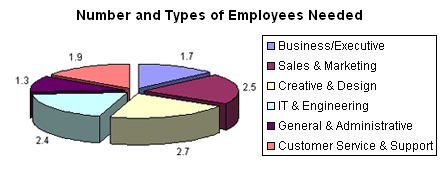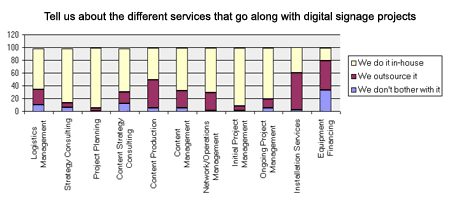How many employees does it take to install and manage a 100-screen network?
In our 2009 Digital Signage Pricing Study, we determined that the "average" 100-screen network takes somewhere between 7 and 15 people to run, with an average of around 9 people. Then, in our 2010 Digital Signage Pricing Study, we left the average headcount at 9, but slightly upped the average salary for these personnel to $52.5K, reflecting an across-the-board increase of 5%. That's equivalent to $39,375/month in expenses, or $394/screen/month. In total, the "average" screen in a "typical" 100-screen network in our 2010 study cost about $497/month after salaries were factored in, and thus a 100-screen network would have needed to earn just under $50,000/month to break even.
This year, instead of going through the horribly laborious process of contacting companies and figuring out the average headcount, we decided to simply ask survey takers for their input. In the past, I always asked a variety of companies -- from network owners to software vendors -- for their input. So, I figured that having all of those different parties answer through the survey mechanism would produce reasonably similar results -- good enough for our rough estimates, anyway. The end result is that our respondents think it takes an average of 12.4 people to install and operate a 100-screen network over the course of 3 years. Here's the breakdown (which savvy readers may notice adds up to 12.5 people instead of 12.4 due to rounding):

We see a slight preference for creative and design staff, perhaps stemming from an increased awareness of the need to get fresh and engaging content up on the screens. Meanwhile, when considering how much technology is involved in the typical network, companies seem to be operating with relatively few IT and technical staffers. This may be attributable to the increased ease-of-use of today's software solutions, or possibly a greater reliance on SaaS platforms and other means of IT outsourcing.
When it comes to calculating average salaries (which, as always, rely on the questionable estimates from salary.com), we had to bump our numbers up a bit, both to reflect the larger number of executive-level personnel than previously used, and also to track larger economic trends. We ended up with an average salary number of $59k, which is 12.3% higher than our 2010 numbers. Combined with the fact that there are more salaried employees than last year, the total allocation for staffing now seems pretty high: $731,600/year, or about $61K/month. Combined with the approximately $9,750/month needed to cover the component costs (assuming the full amount is amortized over 36 months without any loan or lease expenses), a single screen in our hypothetical 100-screen network costs about $700/month to operate, meaning that the network as a whole would have to earn about $71,000/month to break even. That's an astonishing 40% increase over last year's numbers.
Interestingly, these 12-ish employees are doing a good amount of work, since for the third year in a row, our survey results suggest that most network operators try to handle many tasks in-house rather than outsourcing:

I continue to be baffled by the people who "don't bother with" seemingly essential items like, oh, I dunno, content management, but perhaps that's the reason why there are still plenty of terrible networks out there.
Is operating a digital signage network really more expensive than in the past?
Given all of the other pricing trends we've tracked over the years, that seems highly unlikely. Instead, I think we're witnessing the convergence of several factors in this year's data. First, as noted above, the collection methodology is different than before. Our old method was unsustainable, basically consisting of me spending hours calling and emailing people. Considering that this blog and our pricing reports don't generate any revenue for WireSpring, I couldn't justify spending the time on such a manual process anymore. Still, it does mean that this year's results probably aren't comparable to last year's, despite the flashy math above. Second, a quick spot-check of DOOH networks indicates that there hasn't been any big hiring spree in the last 12 months, and headcounts have generally stayed the same at right around 9-10 people. So, what we're likely seeing is the result of survey respondents trying to estimate what a successful network would require, rather than what the bulk of networks today -- many of which are not successful -- are scraping by with. That would explain the above weighting toward creative and design personnel. We know that making great digital signage content costs money, and many network owners would probably like to have more in-house designers than they can afford to keep on staff today.
Hey, you said you'd talk about content!
You're right, I did. But this article is long enough, so our analysis of content costs will have to wait until next week.
I think a 100-screen network could be run by fewer than 12 people, but the survey results disagree. What do you think? Leave a comment and let us know!

 Subscribe to the Digital Signage Insider RSS feed
Subscribe to the Digital Signage Insider RSS feed
Comments
RSS feed for comments to this post